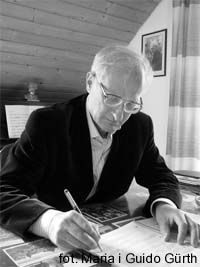Meyer Krzysztof
-
composer, performer
composer, pianist and music tutor, b. 11th August, 1943 in Cracow. He started piano lessons at the age of five. From 1954 he took private lessons in theory and composition with Stanisław Wiechowicz. After graduation from the Fryderyk Chopin Music School in Cracow, he took up studies at the State Higher School of Music in Cracow, where he studied composition - first with Stanisław Wiechowicz, and, after the latter's death, with Krzysztof Penderecki (an honours degree in 1965), as well as theory with Aleksander Frączkiewicz (an honours degree in 1966). In 1964, 1966 and 1968 he continued composition and piano studies with Nadia Boulanger in Paris and Fontainebleau. In 1966 he was granted the Aaron Copland scholarship.
In 1966-68 he played the piano in the Cracow ensemble for contemporary music "MW2". In the same period, he took up teaching. In 1966-87 he taught theory at the Academy of Music in Cracow, of which he was vice-rector in 1972-1975, and in 1975-87 he occupied the chair of music theory. In the academic year 1980/81 he stayed in Hamburg thanks to the "Auswärtige Künstler zu Gast" scholarship. In 1987-2008 he was a professor of composition at the Hochschule für Musik in Cologne; in 2008-2014 he taught again at Cracow’s Academy of Music. In 2009-2013 he was a professor at the Faculty of Musicology, A. Mickiewicz University in Poznań. He has also given lectures on contemporary music in Austria, Brazil, France, Germany, Switzerland, Venezuela and the Soviet Union. He is a member of the Akademie der Künste in Mannheim and Polish Academy of Arts and Science in Kraków. In the 1991/92 concert season he was also composer-in-residence at Cologne Philharmonic, in 1996 - at a festival in Seattle, and in 2013/2014 – at Warsaw Philharmonic.
All of his compositions have been performed; nearly a hundred have appeared in print, and more than 70 have been released on CDs (some of them – several times). Meyer’s music has been performed in many major music centres, incl. the Carnegie Hall in New York, Berlin Philharmonic and the Viennese Musikverein, , as well as at major European festivals: the “Warsaw Autumn”, "Muzički Biennale” in Zagreb, SIMC, "Holland Festival", "Musikprotokoll-Graz", Aldeburgh Festival, Schleswig-Holstein Festival, La Biennale di Venezia and Lucerne Festival. Some of Meyer’s compositions were commissioned by world famous performers: the Flute Concerto – by Aurèle Nicolet, the Oboe Concerto – by Lothar Faber, the Clarinet Concerto – by Eduard Brunner, the Violin Concerto – by Dmitry Sitkovetsky, Trumpet Concerto – by Timofiej Dokszycer, the Lyrical Triptych – by Peter Pears, Pezzo capriccioso – by Heinz Holliger, pieces for cello – by David Geringas, Ivan Monighetti and Boris Pergamenshchikov. Movimento rapsodico for harp was the first Polish composition commissioned to be performed as an obligatory work at the prestigious ARD Competition in Munich in 2016.
He is also the author of books on music, including the first Polish monograph dedicated to the life and work of Dmitry Shostakovich (Cracow 1973 and 1986; German edition - Leipzig 1980). He has published numerous articles, mostly related to contemporary music, in such periodicals as "Melos", "Muzyka", "Ruch Muzyczny", "Das Orchester", "Sovetskaya Muzyka".
He was involved in the activity of the Polish Composers' Union; in 1971-89 he was a member of its Managing Board, in 1985-89 - the President of the Union, and in 1974-88 he also sat on the Repertoire Committee of the "Warsaw Autumn" International Festival of Contemporary Music.
He has received a number of awards for his compositions: in 1966 - 2nd prize in the Young Composers' Competition of the Polish Composers' Union for Symphony No. 1 and 1st prize in the Concours des Jeunes Compositeurs in Fontainebleau for songs to words by Shakespeare; in 1967 - an honourable mention in the Grzegorz Fitelberg Competition for Composers for Symphony No. 2 "Epitaph Stanisław Wiechowicz in memoriam" for mixed choir and orchestra; in 1968 - 1st prize in the same Fitelberg Competition for Symphony No. 3 "Symphonie d'Orphee" for mixed choir and orchestra; in 1970 - Grand Prix de Composition Musicale of the Pierre Prince of Monaco Foundation for his opera Cyberiada and an honourable mention at the International Rostrum of Composers in Paris for String Quartet No. 2; in 1972 - 2nd prize in the Artur Malawski Competition for Composers in Cracow for Concerto da camera for oboe, percussion and strings; in 1974 - 1st prize in the Karol Szymanowski Competition in Warsaw for Symphony No. 4; in 1975 - a Medal granted by the Government of Brazil for String Quartet No. 4; in 1976 - an honourable mention at the International Rostrum of Composers in Paris for String Quartet No. 3, in 1977 - a Medal granted by the Government of Brazil for Concerto retro for flute, violin, cello and harpsichord. Meyer was also granted with the Minister of Culture and Art Award (twice - in 1973 and 1975), the Gold Cross of Merit (1974),the Order of Merit to Polish Culture (1979), the Gottfried von Herder Award (1984), the annual award of the Polish Composers' Union (1992), the Award of the Alfred Jurzykowski Foundation in New York (1994), the Johann Stamitz Award in Mannheim (1996), the Cavalier’s (1997) and Officer’s (2003) Crosses of the Order of Polonia Restituta.
Updated: April 2018 (iz)
Creation
Krzysztof Meyer is a composer distinguished by a deep intellectual self-awareness as an artist. In a questionnaire for “Res Facta” magazine of 1971, the then 26-year-old composer wrote: “In my own works, my point of departure was the twelve-note music (Piano Sonata No. 1), after which I adopted the so-called “bruitist energeticism” derived from Varèse, a style of which Górecki and (to some extent) also Penderecki (Symphony No. 1) are the main exponents in our country. Later, I embraced the aleatory technique in various forms (controlled, as in Piano Sonata No. 4, poly-version, as in the Trio for flute, viola and harp, and poly-structural, as in Symphony No. 2). From each of these techniques, I strove to extract those possibilities which seemed to be beneficial to my own sound world, and I abandoned them the very moment I lost interest in them and grew tired of them. And still, some aspects of these techniques have stayed with me. Also today, some elements of serialism are indispensable to me, as also are the poly-version and poly-structural techniques. If these brief remarks are to serve as self-presentation, I should also add that in composition I thoroughly enjoy, and derive much fun, from using various techniques. Among the latest ones there is not a single one that would be totally without interest to me. Applying various techniques gives me much more enjoyment now than I once derived from plunging into a stream of percussive effects on string instruments (String Quartet No. 1). Applying various techniques is for me only a means to composition, and it is by no means an exaggeration or a false boast to say that I can enter some regions of my inner soundscape using any technical means available and I will still arrive at a result that I had aimed at from the start, regardless of the means applied.” („Res Facta” nr 5, 1971).
Krzysztof Meyer began his artistic activity in the period of the dominance of avant-garde trends and ideas. In the sphere of sound, he was also looking for new sound colours, but sonorism never distorted his sense of form as a process with some internal dramatic development, with stages characterised by varying tension. Before long, he abandoned the avant-garde ideas of sound and stood up for the traditional aesthetic categories – formal order, a balance between elements of the composition, and beautiful sound. Many of his compositions bear names derived from the classical tradition, suggestive of traditional forms: they are symphonies, concerts, quartets and sonatas. But the general concept of form is in fact Meyer’s only link to tradition. Both the internal structure of his works and their sound language are an expression of a fully conscious and individual use of the modern art of composition.
In the context of intellectual self-awareness, we should mention Meyer’s musicological writings: the essential monograph on Dmitry Shostakovich, his favourite composer, which was translated into several languages, the two-volume biography of Witold Lutosławski (written together with his wife), as well as numerous papers and articles on 20th-century music and artists and selected elements of music theory. Since 1966, he has lectured without intermission on theoretical musical subjects.
Compositions
Cello Sonata No. 1 op. 1 (1959-61)
Introspection for five cellos op. 2 (1960)
Aphorisms for piano op. 3 (1961)
Music for three cellos, kettledrums and piano op. 4 (1961-62)
Piano Sonata No. 1 op. 5 (1962)
Piano Sonata No. 2 op. 7 (1963)
String Quartet No. 1 op. 8 (1963)
Songs of Resignation and Denial for soprano, violin and piano op. 9 (1963)
Interludio statico for clarinet and four cellos op. 11 (1963-64)
Concerto da camera for flute, percussion and strings op. 6 (1964)
Symphony No. 1 op. 10 (1964)
Violin Concerto No. 1 op. 12 (1964-65)
Piano Sonata No. 3 op. 13 (1964-66)
Quartettino for soprano, flute, cello and piano op. 16 (1966)
Symphony No. 2 “Epitaphium Stanisław Wiechowicz in memoriam” for mixed choir and orchestra op. 14 (1966-67)
Hommage à Nadia Boulanger for flute, viola and harp op. 17 (1967)
Five Chamber Pieces for mezzo-soprano, clarinet, violin and viola op. 18 (1967)
Cyberiada op. 15 comic opera in 3 acts (1967-70)
Symphony No. 3 “Symphonie d’Orphee” for mixed choir and orchestra op. 20 (1968)
Piano Sonata No. 4 op. 22 (1968)
String Quartet No. 2 op. 23 (1969)
Quattro colori for clarinet, trombone, cello and piano op. 24 (1969-70)
String Quartet No. 3 op. 27 (1970-71)
Concerto da camera for oboe, percussion and strings op. 29 (1972)
Sonata for solo harpsichord op. 30 (1972-73)
Symphony No. 4 op. 31 (1973)
Concerto for trumpet and orchestra op. 35 (1973-75)
String Quartet No. 4 op. 33 (1974)
Polish Songs for soprano and orchestra op. 34 (1974)
Magic Images for piano op. 21a (1975)
Sonata for Solo Violin No. 1 op. 36 (1975)
Sonate de sons rayonnants for piano (1975-2003)
Moment musical for cello (1976)
Fireballs for orchestra op. 37 (1976)
Lyric Triptych for tenor and chamber orchestra op. 38 (1976)
Concerto retro for flute, violin, cello and harpsichord op. 39 (1976)
Three Pieces for percussion and tape op. 40 (1976)
Symphony in D major in Wolfgang Amadeus Mozart’s style op. 41 (1976-77)
String Quartet No. 5 op. 42 (1977)
Twenty-Four Preludes for piano op. 43 (1977-78)
Children’s Suite for piano op. 25a (1978)
Symphony No. 5 for strings op. 44 (1978-79)
Nine Epigrams by Stanisław Jerzy Lec for soprano and piano op. 45 (1979)
Piano Concerto op. 46 (1979)
Interludio drammatico for oboe and ensemble op. 48 (1979-80)
The Countess op. 49, a ballet in one act based on an opera by Stanisław Moniuszko (1980)
Trio for violin, cello and piano op. 50 (1980)
Sonata per flauti solo op. 52 (1980)
The Players op. 53, a full version of the opera by Dmitry Shostakovich in 2 acts (1980-81)
Six Preludes for solo violin (1981)
String Quartet No. 6 op. 51 (1981)
Sunday Colloquium in the Street for baritone and piano op. 54 (1981)
Violin Booth for violin and piano op. 55 (1981)
Canzone for cello and piano op. 56 (1981)
Sonatina for the Young for violin and piano op. 55a (1981-83)
Symphony No. 6 “Polish Symphony” op. 57 (1982)
Hommage à Johannes Brahms for orchestra op. 59 (1982)
Pezzo capriccioso for oboe and piano op. 60 (1982)
Concerto for flute and orchestra op. 61 (1983)
Sonata for cello and piano op. 62 (1983)
Canti Amadei op. 63, concerto da camera for cello and orchestra (1983-84)
Concerto da camera for harp, cello and strings op. 64 (1984)
String Quartet No. 7 op. 65 (1985)
String Quartet No. 8 op. 67 (1985)
Concerto retro for flute, harpsichord and strings op. 39a (1986)
Quartet for 4 saxophones op. 65a (1986)
Clarinet Quintet op. 66 (1986)
Capriccio for 6 instruments op. 69 (1987-88)
Musica incrostata per orchestra op. 70 (1988)
Wyelichalnaya for mixed choir op. 71 (1988)
Wittener Kammermusik for flute, oboe and clarinet (1988)
Maple-Tree Brothers op. 72, a children’s opera in 2 acts (1988-89)
Caro Luigi for 4 cellos and strings op. 73 (1989)
Fanfare für acht Posaunen (1989)
String Quartet No. 9 op. 74 (1989-90)
Fantasy for organ op. 75 (1990)
Monologue for solo cello (1990)
Piano Quintet op. 76 (1990-91)
Pezzo per Mauro for flute, alto saxophone, trombone, piano, double bass and percussion op. 77 (1991)
Concerto for alto saxophone and string orchestra op. 79 (1992)
Carillon pour orchestre op. 80 (1992-93)
Trio for flute, viola and guitar op. 78 (1992-94)
String Trio op. 81 (1993)
String Quartet No. 10 op. 82 (1993-94)
Misterioso for violin and piano op. 83 (1994)
Cello Concerto no. 2 op. 85 (1994-95)
Te Deum for mixed choir op. 84 (1995)
Sonata for violin and orchestra op. 86 (1995)
Mass for mixed choir and orchestra op. 68 (1995-96)
Farewell Music for orchestra op. 88 (1997)
Au delà d’une absence for string quartet op. 89 (1997)
Trio for clarinet, cello and piano op. 90 (1997-98)
The Creation of the World op. 91, oratorio (1999)
Capriccio interrotto for violin and piano op. 93 (2000)
Impromptu multicolore for two pianos op. 92 (2000)
Les sons rayonnants for 2 player pianos and computer (2000)
Cinque colori op. 94 for flute, violin, cello, percussion and piano (2001)
Concerto for clarinet and orchestra op. 96 (2001)
String Quartet No. 11 op. 95 (2001)
Symphony No. 7 „Of the Passing Time” op. 97 (2001-2002)
Trio for oboe, bassoon and piano op. 98 (2002)
Sonata No. 2 for cello and piano (2003-2004)
Epitaph for 3 cellos and piano op. 100 (2004)
Duetti concertanti for bassoon and piano op. 101 (2004)
Metamorphoses for alto saxophone and piano op. 102 (2004)
String Quartet No. 12 op. 103 (2004-2005)
Quasi una fantasia for piano op. 104 (2005)
Double Concerto for violin, cello and orchestra op. 105
(2005-2006)Burlesca all’Ongarese for solo flute (2006)
Sonata breve for piano op. 106 (2006)
Quintet for Four Saxophones and Piano op. 107 (2006-2014)
Musique scintillante for 14 instruments op. 108 (2007)
Sonata for Solo Cello No. 2 op. 109 (2007)
Duetti per due violini op. 110 (2008)
Symphony No. 8 (Sinfonia da Requiem) for choir and orchestra op. 111 (2008-2009)
Quartet for Violin, Viola, Cello and Piano op. 112 (2009)
String Quartet No. 13 op. 113 (2009-2010)
Imaginary Variations for violin and piano op. 114 (2010)
Concerto for Guitar, Timpani and String Orchestra op. 115 (2010-2011)
Chansons d’un reveur solitaire for soprano and orchestra to poems by Paul Verlaine op. 116 (2011-2012)
Musique de la lumiere et de la penombre for chamber orchestra op..118 (2012)
Five Contredanses for two orchestras op. 119 (2013)
Nehmt hin die Welt for mixed choir a cappella to words by Friedrich Schiller op. 120 (2013)
Sei Intermezzi for piano op. 121 (2013)
Triptych Sonata for guitar op. 125 (2014)
String Quartet No. 14 op. 122 (2014)
3 x 4 for cello and piano op. 123 (2014)
Musica festiva for organ and orchestra op. 124 (2014)
Symphony of Faith and Hope No. 9 to Psalms of King David op. 126 (2015)
Metamorphosen for small orchestra op. 128 (2015-2016)
Movimento rapsodico for solo harp op. 127 (2016)
Trio for flute, violin and cello op. 129 (2016)
Musica concertane per violoncello, pianoforte, percussione ed archi op. 130 (2016)
String Quartet No. 15 op. 131 (2016-2017)
Miroirs au carré for orchestra op. 132 (2017)
Sonata for Solo Violin No. 2 op. 133 (2018)
Publications
books
Szostakowicz [Shostakovich], PWM, Kraków 1973, 1986
Witold Lutosławski, Ars Nova, Poznań 1994
Gwizdalanka Danuta / Meyer Krzysztof, Lutosławski. Tom I: Droga do dojrzałości [Lutosławski. Vol. I: The Road to Maturity], PWM, Kraków 2003
Gwizdalanka Danuta / Meyer Krzysztof, Lutosławski. Tom II: Droga do mistrzostwa [Lutosławski. Vol. II: The Road to Mastery], PWM, Kraków 2004
Dymitr Szostakowicz i jego czasy [Dmitri Shostakovich and His Times]
, Fayard, Paryż 1994 i 2009; Lübbe-Verlag, Bergisch Gladbach 1995; Uitgeverij Atla, Amsterdam 1996; Allianza Musica, Madryt 1997 i 2011; Atlantis, Zurich 1998; Kompoziitor, St. Petersburg 1998; PWN, Warszawa 1999; Olympus, Amsterdam 2006; Molodaya Gvar, Moskwa 2006; Schott, Mainz 2008Mistrzowie i przyjaciele [Masters and Friends], PWM, Kraków 2011
Witold Lutosławski. Wege zur Meisterschaft, (we współautorstwie z D. Gwizdalanką), Pfau, Saarbrücken 2014
Literature
Haute-musique Krzysztofa Meyera [Krzysztof Meyer's Haute-musique], Rozmowa z kompozytorem [Interview with Composer]
Maciejewski Bogusław, Twelve Polish Composers, Allegro Press, London 1976
Helman Zofia, Krzysztof Meyer, in: Komponisten der Gegenwart (eds. Hanns-Werner Heister, Walter-Wolfgang Sparrer), edition text + kritik, München 1992-
Piątek Katarzyna, Symfonie Krzysztofa Meyera [Krzysztof Meyer's Symphonies], in: Krakowska szkoła kompozytorska 1888-1988 [The Cracow School of Composition 1888-1988] (ed. Teresa Malecka), Akademia Muzyczna w Krakowie, Kraków 1993
Krzysztof Meyer. Do i od kompozytora [Krzysztof Meyer. To and From the Composer], Ars Nova, Poznań 1994
Jabłoński Maciej, Homma Martina (Hg.), Krzysztof Meyer. Ein Komponistenportrait, Ars Nova / Bela Verlag, Poznań - Köln 1998
Helman Zofia, Meyer Krzysztof, In: Encyklopedia Muzyczna PWM (część biograficzna pod red. Elżbiety Dziębowskiej), t. „m” [PWM Music Encyclopaedia, biographical part ed. by Elżbieta Dziębowska], vol. “M”, PWM, Kraków 2000
Thomas Adrian, Meyer Krzysztof, In: The New Grove Dictionary of Music and Musicians. Second Edition (ed. Stanley Sadie), vol. 16, Macmillan Publishers Limited, London 2001
Weselmann Thomas, Musica incrostata. Szkice o muzyce Krzysztofa Meyera [Musica incrostata. Notes on the Music of Krzysztof Meyer], Wydawnictwo Poznańskiego Towarzystwa Przyjaciół Nauk, Poznań 2003
Interdisciplinary Studies In Musicology [Special Issue], ed. by J. Humięcka-Jakubowska and D. Jasińska, Wydawnictwo Naukowe UAM - PTPN, Poznań 2013










